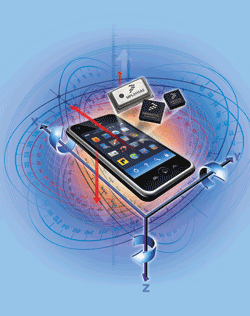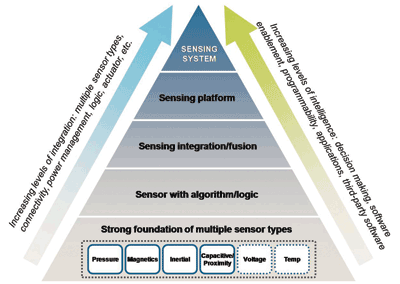Knowing the fusion support available for sensors based on microelectromechanical systems can help jump start designs
BY KAREN LIGHTMAN
managing director
MEMS Industry Group
www.memsindustrygroup.org
Sensor fusion—the intelligent combination of data from several sensors for the purpose of improving application or system performance—has the MEMS industry abuzz with promise. With potentially attractive benefits that include the ability to meet or exceed power, performance, and cost requirements in heterogeneous embedded systems—including mobile handsets and tablets—sensor fusion is moving rapidly into the commercialization phase.

We polled several MEMS Industry Group (MIG) member companies about their respective approaches to sensor fusion, presenting an industry snapshot of solutions. For Jay Esfandyari, MEMS product marketing manager, STMicroelectronics, “sensor fusion uses a set of digital filtering algorithms to compensate for the disadvantages of individual sensors to output accurate dynamic information, such as might be used in a location-based sensor.” And while “sensor fusion” has won its place in the technical lexicon, “multi-sensor data fusion” more accurately describes this functionality.
Dave Rothenberg, worldwide marketing manager, Movea, joins ST in the data fusion “camp.” He explains that as “additional sensors become more commonly used in devices, we are seeing the need to support new data sources as well. Data fusion includes not only data from sensors, but also data from sources such as map data and biomechanical data.”
According to Mike Stanley, systems engineer, Freescale Semiconductor, the whole is greater than the sum of its parts when it comes to sensor fusion. “Sensor fusion lets designers trade off strengths and weaknesses of various sensors in order to achieve far greater optimizations,” he notes. “Taking advantage of known data redundancies among sensors and leveraging the knowledge of system transfer functions, dynamics or kinematics, sensor fusion improves the overall quality and noise level of computed results.”
Ed Brachocki, director of marketing, Kionix, identified the technology drivers of sensor fusion. “Mobile operating systems such as Microsoft Windows 8 and Google Android,’ he states, “increasingly support applications that utilize multiple sensors. They are driving the need for flexible, scalable software solutions that allow intelligent management of resources.”
As members of the larger MEMS ecosystem, these MIG members shared a great deal of commonality in explaining the “what is it?” and “why is it?” of sensor/data fusion. But it’s the “how is it?” that revealed some interesting variations.
A fusion library
The electronic compass sensor-fusion library from Bosch Sensortec supports the combination of 3-axis geo-magnetic sensor and 3-axis accelerometer. Enabling 6 degrees-of-freedom (DOF), this software provides tilt compensation, calibrates the electronic compass, and corrects for both magnetic offsets and accelerometer output data.
Last month at the 2012 International CES, Bosch Sensortec expanded its offering from a 6-axis solution to a complete 9 DOF sensor-fusion library, by adding support for its new consumer 3-axis gyroscope. The sensor-fusion software gives manufacturers a complete plug-and-play system solution for navigation and motion control.
Bosch Sensortec provides customers software library versions of its sensor-fusion solution for various flavors of Android, Windows Phone, and other operating-system architectures.
The benefits of sensor fusion are two-fold, according to Leopold Beer, global marketing director, Bosch Sensortec: ”Intelligent sensor-fusion software not only adds the raw sensor data into one system, it also enhances the resulting output through advanced algorithms. This frees designers from the challenges of integrating heterogeneous sensors in a single application, thereby speeding design-to-delivery cycles.”
Fusion code
For its magnetic compass, Freescale offers advanced 6-axis (accelerometer and magnetometer) fusion code. The company includes a hard/soft iron magnetic compensation solution which automatically corrects errors caused by many forms of magnetic distortion. They also offer a pedometry code that runs directly on their MMA955xL intelligent motion-sensing platform.
Sensor-fusion software for Freescale’s basic electronic compass, which it calls Ecompass, is available in source code for use exclusively with Freescale’s Xtrinsic Sensors. Pedometry and advanced magnetometer compensation routines are reserved for use with Freescale products only.
Freescale is developing a 9-axis solution that will utilize gyro compensation for magnetometer and accelerometer readings. In 2012, the company will interface to a higher level in Android/Windows stacks to provide information for location-based services, augmented reality, and other advanced applications (see Fig. 1 ).

Fig. 1. Freescale’s Xtrinsic Sensor Fusion algorithms allow designers to expand the user experience with smartphones, tablets and other smart mobile devices that require multiple sensing technologies and move to intellignet sensing systems.
Scalable fusion
At the 2012 International CES, Kionix launched its sensor-fusion solution. Fully scalable, the new sensor-fusion software can be used for accelerometer and magnetometer (AM), accelerometer and gyroscope (AG), and, accelerometer, magnetometer and gyroscope (AMG) combinations. The Kionix software targets smartphones, tablets and other mobile devices, supporting real-time, floating-point and 32-bit mobile phone OSs—including Android and iCore Windows 8.
The new software is available with compatible Kionix sensors. It also supports third-party sensors as well as third-party or custom-developed software for gesture recognition, activity monitoring, or other desirable functions.
Fusion suite
The iNEMO Engine Sensor Fusion suite from STMicroelectronics is based on Kalman Filter theory, and employs a set of adaptive prediction and filtering algorithms that make sense of all the complex information coming from multiple sensing devices, including accelerometers, gyroscopes (Fig. 2 ), compasses and pressure sensors.

Fig. 2. iNEMO Engine Sensor Fusion suite supports complex devices like the STMicroelectronics gyro, shown here in cross section, to ensure high-accuracy and -resolution.
The software automatically corrects measurement distortions, inaccuracies and interference among the sensors, to raise the bar on motion-sensing realism. ST’s iNEMO Engine Sensor Fusion Suite includes the iNEMO Engine Lite, a free software library for motion-detection system evaluation, and the iNEMO Engine Pro, a compiled software library with data-fusion algorithms for multi-sensor output processing, customizable for different operating systems and hardware platforms.
iNEMO—which works with ST’s and third-party sensors—is a “value-added element with purchases of the iNEMO Engine used with ST’s sensors.”
Agnostic fusion
Movea is uniquely positioned within the sensor-supplier ecosystem. Rothenberg explained that the company is “sensor-agnostic, working with all of the major sensor vendors across multiple releases of their products.”
He provided insight into Movea’s software solution: the “Chemistry of Motion,” through which it has identified the fundamental elements of human motion. “These ‘atomic’ elements, can be combined to create molecules of richer, more complex, end-user motion features. We then develop a flexible ‘chemistry’ framework with tools that allow us and our customers to rapidly prototype new, high-value features often within a matter of days.”
When asked how sensor fusion will evolve, Rothenberg predicted that mobile devices will evolve as “sensor hubs” abundant with different sensors. He added that Movea is working with pressure and sound in addition to accelerometers, magnetometers, and gyros.
A good start
With MEMS motion-sensing hardware and software suppliers bringing a fertile cornucopia of sensor/data fusion solutions to the marketplace, OEMs will be better equipped to augment motion-sensing functionality in their end-user applications with far greater ease. In the end, however, consumers will be the ultimate winners, as the mobile handset/tablet/e-reader/game controllers of the near future will engage them in ways that we have only just begun to imagine. ■
Advertisement
Learn more about MEMS Industry Group





